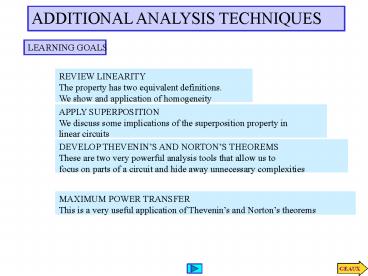ADDITIONAL ANALYSIS TECHNIQUES - PowerPoint PPT Presentation
1 / 17
Title:
ADDITIONAL ANALYSIS TECHNIQUES
Description:
Ohm's law. Now we set to zero the current source. Voltage Divider. LEARNING EXAMPLE ... and V'o using Ohm's law. WHEN IN DOUBT... REDRAW! Sample Problem ... – PowerPoint PPT presentation
Number of Views:65
Avg rating:3.0/5.0
Title: ADDITIONAL ANALYSIS TECHNIQUES
1
ADDITIONAL ANALYSIS TECHNIQUES
LEARNING GOALS
REVIEW LINEARITY The property has two equivalent
definitions. We show and application of
homogeneity
APPLY SUPERPOSITION We discuss some implications
of the superposition property in linear circuits
DEVELOP THEVENINS AND NORTONS THEOREMS These
are two very powerful analysis tools that allow
us to focus on parts of a circuit and hide away
unnecessary complexities
MAXIMUM POWER TRANSFER This is a very useful
application of Thevenins and Nortons theorems
2
THE METHODS OF NODE AND LOOP ANALYSIS PROVIDE
POWERFUL TOOLS TO DETERMINE THE BEHAVIOR OF EVERY
COMPONENT IN A CIRCUIT
The techniques developed in chapter 2 i.e.,
combination series/parallel, voltage divider and
current divider are special techniques that are
more efficient than the general methods, but
have a limited applicability. It is to our
advantage to keep them in our repertoire and use
them when they are more efficient.
In this section we develop additional techniques
that simplify the analysis of some circuits. In
fact these techniques expand on concepts that we
have already introduced linearity and circuit
equivalence
3
SOME EQUIVALENT CIRCUITS ALREADY USED
4
LINEARITY
THE MODELS USED ARE ALL LINEAR. MATHEMATICALLY
THIS IMPLIES THAT THEY SATISFY THE PRINCIPLE OF
SUPERPOSITION
FOR CIRCUIT ANALYSIS WE CAN USE THE LINEARITY
ASSUMPTION TO DEVELOP SPECIAL ANALYSIS TECHNIQUES
FIRST WE REVIEW THE TECHNIQUES CURRENTLY AVAILABLE
NOTICE THAT, TECHNICALLY, LINEARITY CAN NEVER BE
VERIFIED EMPIRICALLY ON A SYSTEM. BUT IT COULD BE
DISPROVED BY A SINGLE COUNTER EXAMPLE. IT CAN BE
VERIFIED MATHEMATICALLY FOR THE MODELS USED.
5
A CASE STUDY TO REVIEW PAST TECHNIQUES
6
(No Transcript)
7
The procedure can be made entirely algorithmic
USING HOMOGENEITY
1. Give to Vo any arbitrary value (e.g., Vo 1 )
2. Compute the resulting source value and call it
V_s
Assume that the answer is known. Can we Compute
the input in a very easy way ?!!
If Vo is given then V1 can be computed using an
inverse voltage divider.
This is a nice little tool for special
problems. Normally when there is only one source
and when in our judgement solving the
problem backwards is actually easier
And Vs using a second voltage divider
Solve now for the variable Vo
8
SOLVE USING HOMOGENEITY
9
LEARNING EXTENSION
10
Source Superposition
This technique is a direct application of
linearity.
It is normally useful when the circuit has only a
few sources.
11
FOR CLARITY WE SHOW A CIRCUIT WITH ONLY TWO
SOURCES
12
The approach will be useful if solving the two
circuits is simpler, or more convenient, than
solving a circuit with two sources
We can have any combination of sources. And we
can partition any way we find convenient
13
LEARNING EXAMPLE
WE WISH TO COMPUTE THE CURRENT
Once we know the partial circuits we need to be
able to solve them in an efficient manner
14
LEARNING EXAMPLE
15
LEARNING EXAMPLE
We must be able to solve each circuit in a very
efficient manner!!!
If V1 is known then Vo is obtained using a
voltage divider
V1 can be obtained by series parallel reduction
and divider
Set to zero current source
16
Sample Problem
1. Consider only the voltage source
2. Consider only the 3mA source
3. Consider only the 4mA source
17
(No Transcript)































